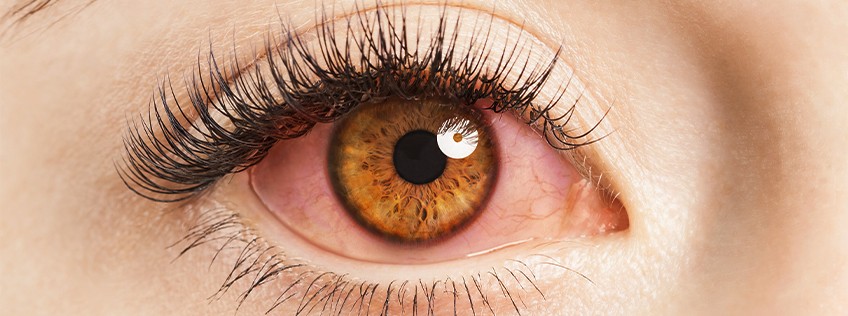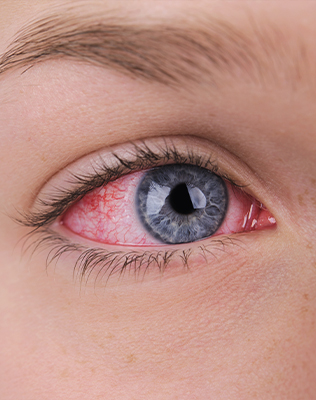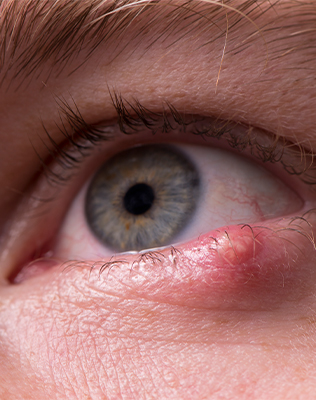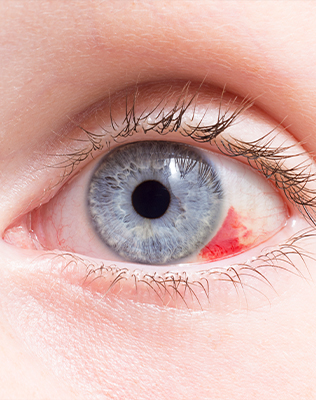Centre-du-Québec
Chaudière-Appalaches
Eastern Townships
Lac Saint-Jean
Lanaudière
Montérégie
Montreal
North Shore
Outaouais
Centre-du-Québec
Eastern Townships
Lac Saint-Jean
Lanaudière
Montérégie
Outaouais
Centre-du-Québec
Chaudière-Appalaches
Eastern Townships
Lac Saint-Jean
Lanaudière
Montérégie
Montreal
North Shore
Outaouais
Back to articles
Red eyes: What to do and when to see a doctor

Are red eyes serious? That depends. Red eyes are often caused by the dilation of a blood vessel or a small rupture in a blood vessel in the eye. But other factors can contribute to red eyes too—sometimes these are minor, but in other cases it can be much more severe. Here are the most common causes of red eyes and some symptoms to look out for so you'll know when it's time to consult an optometrist.
Mild irritation
Allergies or fatigue can cause your eyes to become irritated, thus resulting in redness. Fortunately, these symptoms can be easily treated, and in most cases will resolve in just a few hours.
How to treat it
Are you feeling tired? Try resting and relaxing your eyes. Remove your contact lenses, steer clear of any digital screens, and wear sunglasses when you're going outside. If you have allergies, antihistamines or eye drops can provide significant relief. Consulting your doctor or pharmacist can help you come up with a game plan to reduce your symptoms.
When to see a doctorIf the redness does not improve after 2 days, and if you also notice a sharp pain or sensitivity to light, then you should book an appointment with an optometrist. |
|
Dry eyes
When the surface of your eye is not properly lubricated, it causes insufficient or poor quality tear production. This condition is known as dry eyes and is usually accompanied by a burning or stinging sensation along with redness, irritation, discharge, and blurred vision. There are many levels of dryness, and the type of dryness you're experiencing will determine the severity of your condition. To rate your level of eye dryness, check out our dry eyes test here.
How to treat it
Because this kind of discomfort can lead to corneal irritation or even an eye infection, it is important to treat or consult a doctor as soon as the first symptoms appear. There are several ways to ease these symptoms, including using the numerous products available on the market to help such as artificial tears, cleansing wipes, eye drops or masks. On the other hand, chronic eye dryness may be caused by inflammation or tear glands that don't produce an adequate quantity of tears. Ultimately, only eye care professionals can determine the cause of your eye dryness.
Infectious conjunctivitisA contagious virus or bacteria typically cause infectious conjunctivitis. This eye condition can lead to red eyes, eyelid inflammation, watery eyes, blurred vision, and even a burning sensation. |
|
How to treat it
Avoid touching your eyes, wash your hands regularly and don't share towels, facecloths or cosmetics with anyone else. Most importantly, book an appointment with an optometrist promptly.
|
|
StyesA stye is caused by a blocked tear gland, causing your eye to appear swollen and, in some cases, resulting in pain or sensitivity to the eye. |
How to treat it
Apply a warm water compress for about five to 10 minutes before bedtime. Keep in mind that the compress must be warm and should always be clean. If you prefer, you can use a microwaveable eye mask for comfort and convenience. If the stye causes severe pain, continues to worsen after 48 hours or persists after five to seven days of regular treatment, consult your optometrist.
Other eye diseases and conditions
Red eyes might also be a symptom of something more serious, namely glaucoma, hemorrhaging, an eye injury, lesions, corneal ulcers or inflammation such as scleritis or blepharitis. If the redness is a cause for concern, it will most likely be accompanied by other symptoms such as sharp pain or loss of visual acuity. If any of these occur, you must schedule an emergency appointment with an optometrist as quickly as possible. |
|
If you're experiencing redness in your eyes or notice any other issues to your vision, get in touch with an eye care professional at one of our OPTOPLUS clinics to find out what steps you can take or to make an appointment with an optometrist.
Book an appointment now !




